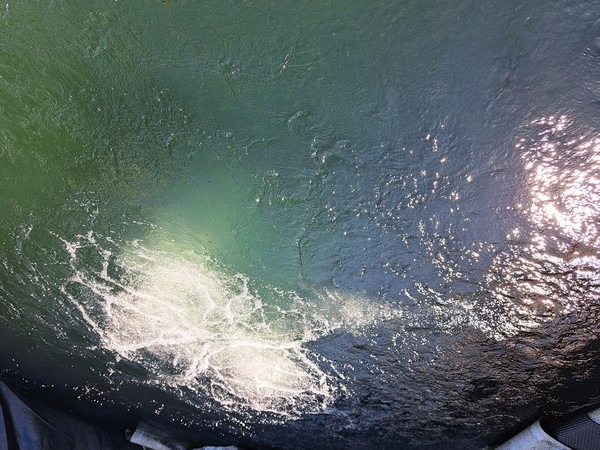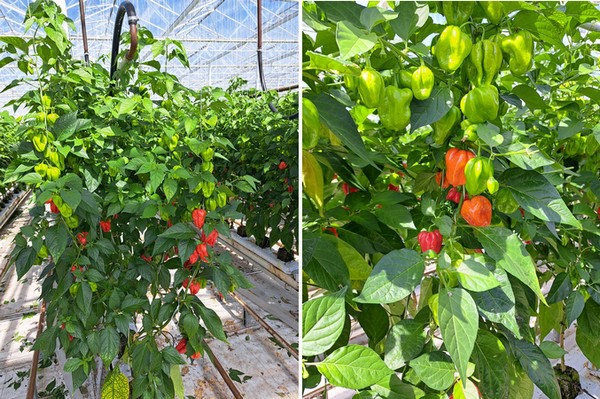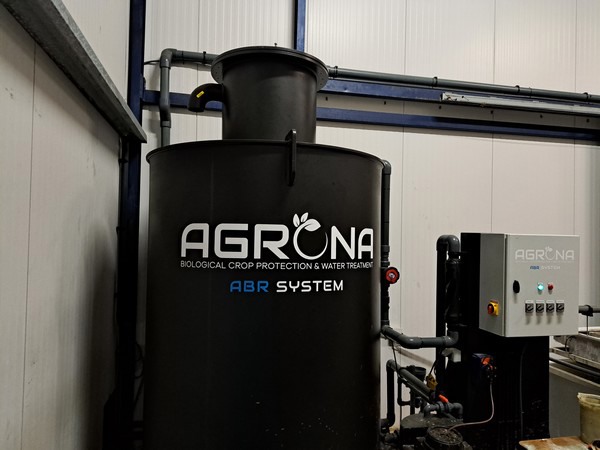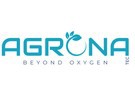Six years ago, Dutch chili grower Arthur Mooijman had algae issues, so he decided to invest in a plate aerator. The grower established a second greenhouse in 2021 and did the same at that site. Since March of this year, an Agrona Oxybull system has been running there. The grower also uses an ABR Bioreactor.
Why did he choose an Oxybull? "I had heard the phrase plate aeration somewhere. I forget where," Arthur answers over a cup of coffee in April. "I started searching on the Internet and came across Nadir from Agrona." That is Nadir Laaguili, who supplies water treatment systems.
Agrona's story appealed to the grower. "A clear video about how it works also helped. At that time, there weren't as many aeration systems on the market as now," begins Arthur. He had been growing in his Nootdorp greenhouse for about ten years when he decided to invest in improving the water in the silo. "I already had a floating tarp, but it was getting dirty."
 A peek into the silo in Nootdorp
A peek into the silo in Nootdorp
Algae problem
The grower had to be a little patient after he had installed the Oxybull. It did not clean the water overnight. "In hindsight, I should've cleaned the silo first; I know that now. At the time, I didn't fully realize that," says Arthur. As a result, when the bubbles started forming, it loosened the dirt from the silo's bottom. "That caused some issues. Later I had the silo vacuumed clean, which solved the problems with the filters getting dirty."
The main reason for his investment was an algae problem. However, the Oxybull also increases the water's oxygen level. Did Arthur measure that too? "No," he admits. "Measuring is, indeed, knowing. But, at the time, I didn't know how much oxygen there was in the drip hoses, so I had nothing with which to compare the figures. The main issue, however, was getting rid of the algae. And that worked well."

New greenhouse with more water storage
In the winter of 2020-2021, Arthur had a greenhouse in Berkel en Rodenrijs converted to grow chilies. This year is the third season he is using the former bell pepper farm. Arthur does not visit every day, thanks to a good, on-site farm manager. He did, however, notice the crop 'not looking as fresh' as he would like after a while.
Mooijman found the water lacked oxygen. "We store quite a lot of water at this new greenhouse. We have silos and underground water storage. But, keeping the water vital is challenging because we don't irrigate much, especially in the winter. Aerating it will improve that," he says.
Balanced microbiology
The grower placed his second Oxybull in the Berkel en Rodenrijs silo in March. An Agrona ABR Bioreactor was already running there. "After the first crop year there, we removed the UV system that was still there. That was because we'd begun organic substrate cultivation. I think resilient cultivation also fits in with that microbiology."
Arthur believes organic substrate farming also calls for a different kind of water treatment. "You want to build a microbiological balance," he explains. To do this, Arthur uses AG-STIM, a biostimulant. When he grew cucumbers, now more than a decade ago - Arthur switched during the EHEC crisis - he was already using biostimulants. "Even then, it yielded good results, like a 20% reduction in fertilizer."
Also, when the weather's highly changeable and the plants are heavily loaded, the grower still sees white roots. "Bad pathogens don't affect the plants, so we don't use anything against 'root diseases' either," Arthur explains. In 2016, Kwekerij Mooijman switched entirely to chilies.

ABR Bioreactor at Kwekerij Mooijman
Fewer aphids
In Nootdorp, Arthur grows partly on perlite and partly on an organic substrate. His choice of the substrate varies per variety, of which Kwekerij Mooijman grows nine. Their position in the greenhouse also varies. Colder or slightly darker corners lend themselves to special types. Regarding their nutritional recipe, the grower has to choose a middle ground. In Nootdorp, though, the grower has different watering sections.
Both the chili farms ultimately want crops that are as good and healthy as possible. The latest investment should help. Last year, the grower saw his choices' effects in Berkel (en Rodenrijs). In the 'aphid year' of 2022, he had problems in Nootdorp but far fewer in Berkel. Arthur sees a relationship with a more resilient crop; the plant seems much 'tougher,' although he also points out that there is always a combination of factors.
Still, one thing is sure: if you do not invest, you cannot keep moving forward. And that is what Arthur wants to do, though he admits he has managed to do so well for years. "You always try to exceed your previous year's production. In Nootdorp, that's gone well since we started growing chilies in 2012, and in Berkel, too, we're well on our way," he concludes.
For more information:
Nadir Laaguili
Agrona B.V.
Mob.: + 31 (0) 621 515 915
Tel.: + 31 (0) 107 371 451
Email: [email protected]
www.agronagroup.com
Kwekerij Mooijman B.V.
18 Oudeweg, 2631 CG
Nootdorp, the Netherlands
Email: [email protected]
www.kwekerijmooijman.nl
